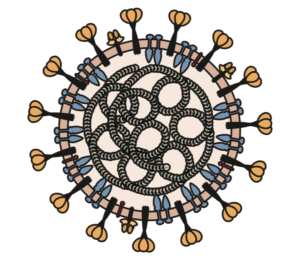Helen is a research associate in David Hafler€™s immunobiology lab at Yale University; previously, she worked on poxviruses at Tonix Pharmaceuticals, and she plans to apply to PhD programs in virology this year.
RT-PCR Diagnostics
As cases of COVID-19 continue to rise, diagnostic testing has been a principal topic of discussion. Typically, quantitative (real-time) reverse transcription polymerase chain reaction (RT-PCR) is used for viral diagnostic testing.
RT-PCR requires a nasopharyngeal swab, which is placed into a viral transport media. Viral RNA is isolated via RNA extraction, which requires the use of a specific test kit. Post RNA isolation, reverse transcription €“ the conversion of RNA into complementary DNA (cDNA) €“ is facilitated by combining the RNA with deoxyribonucleotides and other reagents and exposing the sample to various temperatures.
Once converted to cDNA, the sample is analyzed via PCR. To do so, the cDNA is mixed with specific probes €“ short sequences of DNA that are complementary to signature sequences of the viral genome. These probes contain fluorescent markers that are detected by the real-time PCR machine, which provides a read out quantifying the amount of fluorescence detected. This value is called the Ct number, and is inversely related to the amount of DNA. Typically, Ct numbers are analyzed relative to a ‘housekeeping€™ gene via the comparative Ct method, which uses the difference in Ct values between these samples to determine whether viral sequences are present.
As such, RT-PCR detects the presence of viral RNA in a sample €“ it does not necessarily signify the presence of replicating virus.
Delays to Provide Testing in the US
While effective testing paradigms exist, regulatory barriers and equipment shortages have impeded effective scale-up of COVID-19 testing in the US. In mid-February, the CDC shipped test kits to state and local labs; however, these tests proved defective (Baird 2020). On February 29th, in an effort to increase the nation€™s testing capacity, the FDA allowed certain laboratories to develop and perform their own diagnostic tests (Baird 2020). Later, on March 12th, the FDA issued Emergency Use Authorizations (EUA) to enable commercial companies to manufacture and issue tests while bypassing certain regulatory measures (Baird 2020).
While these new policies increased the number of laboratories authorized to perform diagnostic testing, material shortages continue to halt efforts to escalate testing. There is a particular need for RNA extraction kits, qPCR reagents, and test swabs (Baird 2020). Some labs, unable to keep up with the influx of samples, have resorted to freezing them until they are able to increase their processing power (Baird 2020).
Diagnostic Innovation for COVID-19
Reduced regulation has invited an influx of proposals for novel COVID-19 testing. Two research groups specializing in CRISPR gene-editing technology, Sherlock Biosciences and Mammoth Biosciences, are working with various collaborators to adapt their CRISPR platforms for COVID-19 diagnosis.
The CRISPR-Cas9 mechanism involves the creation of a small segment of RNA with a €œguide€ sequence that binds to a specific target of DNA in a genome. The RNA also binds the Cas9 nuclease, which cuts the DNA at the target location. Research on other Cas nucleases has revealed the use of CRISPR to locate rather than cleave certain sequences within a genome (Prabhune 2020). The nucleases Cas12a and Cas13a have been studied for this particular use. Like Cas9, Cas12a/Cas13a nucleases cleave at the site where complementary guide RNA binds to a specific target sequence (Prabhune 2020); however, upon locating the target sequence, these nucleases also cleave other nearby, non-targeted nucleic acid molecules €“ a mechanism that is appropriated to build reporter systems for a visual diagnostic readout (Prabhune 2020).
Sherlock Biosciences CRISPR-based nucleic acid detection protocol called SHERLOCK (Specific High sensitivity Enzymatic Reporter unLOCKing) targets two SARS-CoV-2 genes €“ the S gene and Orf1ab. It includes three steps: amplification of synthetic viral RNA and in vitro transcription of amplified DNA into RNA; RNA-detection using the Cas13 nuclease; and a visual readout which captures the cleaved reporter RNA (Prabhune 2020).
Mammoth Biosciences€™ platform DETECTR €“ DNA endonuclease-targeted CRISPR trans reporter (DETECTR) €“ is a CRISPR-based detection mechanism that targets the N and E viral genes (Prabhune 2020). It includes the following steps: amplification of extracted RNA; detection of DNA using Cas12a; and a visual readout (Prabhune 2020).
Conclusions
As of March 24, 359,161 COVID-19 tests have been performed in the US (The COVID Tracking Project). For comparison, South Korea is testing nearly 20,000 people per day (Khazan 2020). While there are a lot of promising candidates for new testing paradigms, it remains to be seen how and when these new paradigms might be implemented.
References
Baird RP. Why Widespread Coronavirus Testing Isn€™t Coming Anytime Soon. New Yorker. (2020).
Cormen VM, Landt O, Kaiser M, Molenkamp R, Meijer A, Chu DKW, Bleicker T, Brunink S, Schneider J, Schmidt ML, Mulders DGJC, Haagmans BL, van der Veer B, van den Brink S, Wijsman L, Goderski G, Romette JL, Ellis J, Zambon M, Peiris M, Goossens H, Reusken C, Koopman MPRG, Drosten C. Detection of 2019 novel coronavirus (2019-nCoV) by real-time RT-PCR. Euro Surveill. (2020). doi: 10.2807/1560-7917.ES.2020.25.3.2000045.
Khazan O. The 4 Key Reasons the U.S. Is So Behind on Coronavirus Testing. The Atlantic. (2020). https://www.theatlantic.com/health/archive/2020/03/why-coronavirus-testing-us-so-delayed/607954/
Prabhune M. Coronavirus Detection Using CRISPR Diagnostics. Synthego. (2020). https://www.synthego.com/blog/crispr-coronavirus-detection.
The COVID Tracking Project. https://covidtracking.com/us-daily/


Comments are closed.